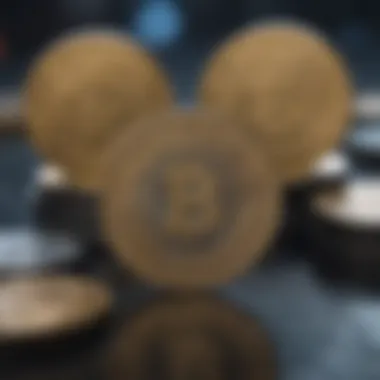Evaluating Tron Coin Exchanges: Key Insights and Trends


Intro
The growth of the cryptocurrency landscape has brought several innovations, and among these, Tron coin exchanges stand out as vital components of digital finance. By facilitating the trading of Tron, these exchanges connect buyers and sellers, contributing to the overall dynamism of the cryptocurrency ecosystem.
When it comes to Tron, a decentralized platform designed for content sharing, its functionalities and relevance extend beyond simple transactions. Understanding the nuances of Tron coin exchanges is crucial for anyone looking to fully engage with this ecosystem—investors and traders alike need to be well-acquainted with the platforms they use.
In this analysis, various aspects will be explored, such as the functions, features, and implications of these exchanges. Armed with this knowledge, readers will be better positioned to navigate the complexities of Tron transactions.
Cryptocurrency Fundamentals
Understanding Blockchain Technology
Blockchain technology serves as the backbone of cryptocurrencies, including Tron. Essentially a distributed and immutable ledger, blockchain ensures transparency and security in transactions. The decentralized nature of blockchain eliminates the need for intermediaries, allowing for peer-to-peer exchanges that are both efficient and cost-effective.
Tron leverages this technology to facilitate a wide array of decentralized applications (dApps) and smart contracts. In essence, every transaction executed through a Tron coin exchange is recorded on the blockchain, fostering trust among users.
Key Concepts in Cryptocurrency Trading
For those new to the world of crypto, grasping fundamental concepts is important. Here are a few highlighted terms:
- Wallets: Digital wallets store cryptocurrencies. They come in various forms—hardware, software, or paper wallets. Understanding how to use them is crucial for safe storage.
- Exchange Types: There are several types of exchanges, including centralized exchanges (CEX), decentralized exchanges (DEX), and peer-to-peer platforms. Each serves a different purpose and has its pros and cons.
- Liquidity: This refers to how easily an asset can be bought or sold without affecting its price. High liquidity can mean lower slippage and better pricing.
Market Insights
Current Trends in the Crypto Market
As of now, the cryptocurrency market displays a myriad of trends. Institutional adoption is on the rise, with large corporations increasingly investing in cryptocurrencies, including Tron. Furthermore, regulatory scrutiny is becoming more pronounced as governments explore frameworks for crypto transactions.
This changing landscape can greatly impact Tron coin exchanges. Investors need to keep their eyes peeled for signs of market shifts.
Analyzing Market Movements and Predictions
Understanding market movements can aid traders in making informed decisions. Tools like charts and candlestick patterns can provide insights into price trends. Here’s a simplified overview of what to consider:
- Volume Analysis: A rise in trading volume often signals strength in a price movement.
- Price Trends: Observing historical trends can offer hints about future movements.
- Fundamental Analysis: Staying updated on news around Tron and its ecosystem can influence trading strategies.
"In trading, it’s not just about having the right strategy but also about timing and understanding the market pulse."
In summary, navigating the realm of Tron coin exchanges involves both understanding the underlying blockchain technology and keeping track of market developments. By doing so, investors and traders can refine their strategies and enhance their engagement with the dynamic cryptocurrency landscape.
Understanding Tron Coin
Understanding Tron Coin is crucial as it lays the foundation for navigating the complex world of cryptocurrency exchanges. Tron stands out in the digital currency sphere due to its unique architecture and underlying technology. This section aims to explore what sets Tron apart from other cryptocurrencies and why investors and traders should have a firm grasp of it before engaging in exchanges.
Overview of Tron
Tron is a blockchain-based platform primarily created to enhance the entertainment and content-sharing industry. The concept focuses on decentralization, allowing creators to connect directly with users without intermediaries. This idea is not just a lofty aspiration. It seeks to tackle the issues of retaining content ownership and ensuring fair remuneration for creators.
Tron was established in 2017 by Justin Sun. Sun's vision was to build a decentralized web that empowers content creators. The platform runs on a native cryptocurrency called TRX. Unlike many cryptocurrencies, where you might exchange coins or tokens for various utilities, Tron emphasizes usability within the network. You can utilize TRX for everything from making transactions to participating in the network's voting mechanism, which ensures a democratic governance structure.
Here’s a quick view of what makes Tron interesting:
- Decentralization: Reducing dependence on centralized entities is at the core of Tron’s mission.
- Scalability: Tron is designed to handle numerous transactions per second, aiming for a faster throughput than Bitcoin or Ethereum.
- Community-Driven: User engagement helps shape Tron's ecosystem, offering everyone a stake in its success.
Use Cases of Tron
Tron’s flexibility opens up various avenues for application, which is why understanding its use cases is vital. Here are a few notable examples that depict Tron's capability:
- Content Creation: Artists can monetize their work directly. Musicians or filmmakers can preserve ownership rights while receiving fair payments.
- Gaming Industry: Many games are being developed on the Tron blockchain, allowing for decentralized game economies and genuine ownership of in-game assets.
- DApps and Smart Contracts: Tron supports diverse decentralized applications (DApps). Developers can create smart contracts without the limitations often seen in other platforms.
- Token Creation: Businesses can create their own tokens on Tron's network, facilitating fundraising or project development.
"For many content creators, Tron serves as a breath of fresh air, allowing them to reclaim time and income lost to traditional gatekeepers."
By analyzing these use cases, it becomes clear that Tron offers practical solutions that go beyond the mere trading of cryptocurrency. Its application in real-world scenarios adds tangible value and increases the relevance of trading and holding TRX in a portfolio. Understanding these elements not only helps in making informed decisions about exchanges but also sheds light on the potential growth of Tron as a platform within the broader cryptocurrency ecosystem.
This section sets the stage for exploring the various exchanges that facilitate TRX trading. It’s paramount to appreciate what Tron is and how it functions before delving into the intricacies of where and how one can buy or sell it.
Types of Cryptocurrency Exchanges


Navigating the world of cryptocurrency can feel like wandering through a maze, and the types of exchanges available play a significant role in shaping one’s trading experience. Understanding the different types of cryptocurrency exchanges is paramount for any investor or trader looking to engage with Tron coins effectively. Each exchange offers its own set of features, security protocols, and transaction processes.
Centralized Exchanges
Centralized exchanges dominate the crypto ecosystem, acting as intermediaries where buyers and sellers meet. These platforms, like Binance and Coinbase, provide a user-friendly interface that appeals to both novices and seasoned traders. The appeal lies in their functionality: they handle a large volume of trades and provide liquidity. When trading on centralized exchanges, users can benefit from features such as limit orders, margin trading, and various charting tools designed to enhance their trading strategies.
However, this convenience does come with its downsides. Centralized exchanges often become prime targets for hackers due to their large pools of assets. Security breaches can lead to significant financial losses for users. Furthermore, since these exchanges hold users’ private keys, there lies the risk of centralized authority over your funds. This raises the question of trust, as users must rely on the exchange to safeguard their investments.
Decentralized Exchanges
On the flip side, decentralized exchanges (DEXs) like Uniswap and SushiSwap operate without a central authority, allowing for peer-to-peer trading. A major advantage of using a DEX is that users retain control over their private keys, reducing the risk of hacks on the platform itself. Transactions on these exchanges are executed on the blockchain, providing greater transparency and, often, more privacy.
DEXs are built for the technologically inclined, which means navigation can be less intuitive than their centralized counterparts. Typically, users need to understand how to connect their wallets, such as MetaMask, to initiate trades. Liquidity can fluctuate more on DEXs, sometimes leading to slippage during large trades. However, they boast unique features such as automated market-making, allowing for trading without placing orders for buyers and sellers.
Hybrid Exchanges
Lastly, we have hybrid exchanges that aim to combine the best of both worlds. These platforms strive to offer the user-friendly interface and liquidity of centralized exchanges along with the security features of decentralized ones. An example is Nash, which allows users to trade directly from their wallets while retaining the usability of a centralized system. Hybrid exchanges often implement advanced security measures, such as multi-signature wallets, to prevent unauthorized access to funds.
However, it’s still an evolving space with its own set of challenges. As hybrid exchanges are relatively new, they may not yet have as extensive a track record as established centralized exchanges. Users must weigh the pros and cons when deciding which type of exchange to utilize.
In summary, when considering which exchange to use for trading Tron coins, it’s crucial to understand the distinctions between these types of platforms. Each has its advantages and disadvantages that can significantly impact trading strategies and security. As the crypto landscape continues to evolve, so too will the exchanges that facilitate these transactions.
Key Players in the Tron Coin Market
Understanding the key players in the Tron coin market is a crucial step for anyone looking to navigate this vibrant corner of the cryptocurrency ecosystem. These players not only facilitate transactions but also influence market trends, liquidity, and overall user experience. When evaluating which exchanges to use for trading Tron Coin, it is essential to recognize the diversity in their offerings, the innovative technologies they deploy, and how they stack up against each other.
Popular Tron Exchanges
In the realm of Tron trading, several exchanges have grown to prominence. Each one comes with its unique features and user advantages. Here are some noteworthy exchanges that stand out:
- Binance: Known for its vast array of trading pairs and user-friendly interface, Binance is a top choice among traders. It offers competitive trading fees and high liquidity, making buying and selling Tron seamless.
- Bittrex: With robust security measures and a high degree of regulatory compliance, Bittrex has carved a niche among investors who prioritize safety alongside accessibility.
- KuCoin: This platform prides itself on providing a host of cryptocurrencies to trade. KuCoin’s decentralized approach attracts users looking for an expansive trading experience.
- Poloniex: Often favored by more experienced traders, Poloniex combines advanced trading tools with a user-friendly platform, catering to those who appreciate deeper analysis and market insights.
"In the ever-evolving landscape of cryptocurrencies, choosing the right exchange can often feel like finding a needle in a haystack. It’s vital to align your trading goals with the platform’s strengths."
While these exchanges are popular, it's also important to conduct your own research to assess their fees, security protocols, and the overall trading environment they foster. Each exchange offers its own blend of functionalities to cater to diverse trading styles.
Emerging Platforms
As the Tron ecosystem continues to mature, several new platforms are popping up. These emerging exchanges often capitalize on unique niches or technological innovations that distinguish them from the more established players.
- JustSwap: Operating on a decentralized basis, JustSwap is known for its automated market-making capabilities. This platform allows users to swap TRC-20 tokens quickly and without the need for a centralized intermediary.
- TronTrade: Focusing solely on Tron and its assets, TronTrade has garnered attention for its seamless user experience and full integration of Tron’s blockchain features.
- DigiFinex: While still growing in recognition, this platform provides a variety of trading options and a responsive user interface that appeals to those looking to jump into the Tron space with ease.
The emergence of these platforms signals a shift toward more user-centric options in the market. With options that prioritize decentralization and unique token offerings, traders might find themselves benefiting from lower fees and better liquidity.
As the Tron coin market evolves, staying alert to both popular exchanges and new entrants can provide an edge for traders looking to maximize their investment.
Evaluating Exchange Features
When diving into the world of Tron coin exchanges, it’s vital to evaluate the exchange features that could make or break your trading experience. A broad spectrum of factors come into play here, including user interface, trading fees, and overall exchange liquidity. Assessing these attributes is not just a technical necessity; they can significantly influence trading effectiveness, profitability, and user satisfaction.
User Interface and Experience
The user interface (UI) of an exchange serves as the first point of contact for traders. A clean and intuitive interface can make a world of difference, particularly for newcomers who may feel lost in the complexities of cryptocurrency trading.
- Simplicity: A straightforward layout with easy navigation helps users to make their transactions without a steep learning curve.
- Accessibility: Many traders favor mobile access to manage trades on the go. Thus, exchanges with mobile-friendly platforms often attract more users.
- Visual Representation: Charts and graphs that effectively visualize price movements are indispensable for traders making split-second decisions.
Creating a seamless experience often leads to increased user engagement. If an interface feels clunky, potential investors might just pack their bags and take off to greener pastures.
Trading Fees and Costs
Every dollar counts, especially when trading in a volatile market like cryptocurrencies. Understanding the various trading fees can influence your bottom line significantly.
- Transaction Fees: This is a fee charged on each trade. Some exchanges flaunt low fees, but may compensate with hidden charges elsewhere. Hence, diligence is key.
- Withdrawal Fees: When cashing out, withdrawal fees can nibble away at your profits, especially if you're not mindful.
- Maker vs. Taker Fees: Each exchange has its own structure here. Maker fees are typically lower, rewarding those who provide liquidity, while taker fees can add up quickly for those who merely want to buy or sell.
Traders must always read the fine print. A seemingly attractive fee structure can sometimes hide costs that surface later on, impacting their overall trading strategy.
Liquidity and Trading Volume


Liquidity refers to how easily an asset can be bought or sold without affecting its price significantly. When evaluating exchanges for Tron coins, look for high liquidity to ensure that your trades are executed swiftly and at desirable prices.
- Market Depth: A deep market means that there are ample buy and sell orders at various price points. This is crucial during market swings where quick actions lead to tighter spreads.
- Trading Volume: Exchanges with higher trading volumes often demonstrate greater reliability. It indicates a level of trust and engagement from other traders, which can be particularly reassuring.
Investors should have a keen eye on these factors to avoid potential pitfalls associated with poorly liquid markets, which can lead to difficulty executing trades at expected prices.
Understanding these features provides insight into how well-suited a given exchange may be for your trading needs.
Summing it up, evaluating exchange features is more than just a box-ticking exercise; it’s a measure of your ability to navigate through the unpredictable nature of cryptocurrency trading effectively.
Security Considerations in Exchange Selection
When it comes to trading in cryptocurrency, security cannot be taken lightly. As Tron coin becomes ever more popular, choosing the right exchange is paramount for your safety and peace of mind. In this section, we will explore why security considerations should weigh heavily on any trader's mind, particularly those delving into the Tron ecosystem. Understanding how to evaluate exchanges based on their security measures is essential to mitigate risks and protect your investments.
Traders and investors need to grasp that the crypto market is not as regulated as traditional finance. This presents not just opportunities, but a minefield of potential dangers. Whether it’s hacking attempts, technical vulnerabilities, or inadequate user authentication protocols, these risks can wreak havoc in the wallets of unprepared traders. By prioritizing exchanges that have robust security features, you not only ensure the safety of your assets but also reinforce the trustworthiness of your trading activities.
Security Protocols
Security protocols play a crucial role in safeguarding funds and information. Robust trading platforms rely on multiple layers of security to protect their users. Some essential protocols include:
- Two-Factor Authentication (2FA): This adds an extra layer of security beyond just the password. It requires an additional code sent to your phone, ensuring that you are indeed the one trying to access the account.
- Cold Storage for Assets: Many reputable exchanges use cold storage for the bulk of their cryptocurrencies. This means your assets are kept offline, making it much harder for hackers to access them.
- End-to-End Encryption: This ensures that all communications between the user and the exchange platform are encrypted, making it difficult for malicious actors to intercept sensitive data.
- Regular Security Audits: Trustworthy exchanges periodically conduct security audits to discover and rectify vulnerabilities. Being open about their security practices often indicates that a platform takes user protection seriously.
"Not all exchanges are created equal; security protocols can make or break your trading experience."
Investors should also look into the exchange's incident history. A platform with a clean record often reflects a commitment to maintaining high security standards. Take note of how exchanges respond to breaches; an exchange that is transparent in its dealings will inspire more confidence among its users.
Regulatory Compliance
In today’s regulatory landscape, compliance acts as a cornerstone of operational legitimacy. For a Tron coin exchange to be reliable, it must abide by the regulations set by the relevant authorities in its operating jurisdictions. Regulatory compliance factors significantly into the safety net of any exchange for several reasons:
- Trust and Credibility: An exchange that complies with regulations proves that it operates under the watchful eye of legal frameworks. This often translates to better practices surrounding user data and privacy.
- Investor Protection: Many countries enforce laws designed to protect investors from fraud and scams in the cryptocurrency space. Engaging with compliant exchanges reduces the chance of falling victim to malicious tactics.
- Incident Reporting: Compliance often comes with requirements for regular reporting and transparency, providing a layer of accountability for exchanges in how they handle operations and transactions.
- Insurance Coverage: Depending on the regulatory framework, some exchanges may also offer insurance for funds held within their platform, adding an extra layer of safety for users.
Selecting an exchange should also involve a thorough investigation into how responsive it is to regulatory changes. A proactive approach towards compliance not only reflects an exchange’s integrity but is also an indicator of its long-term survival in the market.
Practical Steps for Trading Tron
Trading Tron effectively requires more than just a cursory understanding. Engaging in the crypto space can feel like navigating a maze, with twists and turns at every corner. But, breaking it down into manageable steps makes the entire process far more approachable. Knowing how to trade Tron efficiently is pivotal for investors and traders alike. It sets a solid foundation that ensures transactions run smoothly while minimizing the risks involved.
This section focuses on the essential steps that a trader or investor must take, unraveling the complexities of engagement within Tron exchanges. By understanding the foundational processes—like account creation, fund deposits, and executing trades—one can help secure a footing in this digital economy.
Creating an Account
Opening an account on a Tron exchange is your first step into the world of cryptocurrency trading. This stage is crucial as it essentially provides you with the keys to your trading kingdom.
- Choose Your Exchange Wisely: Not all exchanges are created equal. Each platform may vary in regard to its user interface, fees, and security features. Start with research to pick one that aligns with your needs.
- Registration Process: To create an account, you’ll generally need to provide personal information such as your name, email address, and potentially your phone number for verification. This process can feel tedious, but it's essential for security and compliance with regulations.
- Verification: Depending on the exchange, you might be required to complete KYC (Know Your Customer) procedures. Be prepared to upload identification, which helps legitimatize your account and provides greater access to trading options.
This initial setup may seem like a chore, but it lays a strong groundwork for future trading.
Depositing Funds
You can't trade Tron without first having some funds in your exchange account. Depositing is straightforward but can require careful attention to detail.
- Linking a Wallet: Some exchanges allow you to deposit from various wallets. Ensure that your selected wallet is compatible with Tron coin.
- Deposit Methods: Look over the available deposit methods—bank transfers, credit cards, and even other cryptocurrencies can be options. Take note of transaction fees associated with each method.
- Minimum Amounts: Exchanges usually have minimum deposit limits. Make sure you meet these to get started without hurdles or delays.
Once funds are in your account, you're ready to dive into trading. It's important to remember that the speed of processing can vary across platforms, so don’t let impatience cloud your judgment waiting for your deposit to clear.
Executing Trades
After depositing your funds, the next step is where the rubber meets the road: executing trades. This is where strategy comes into play, as not all trades are created equal. To maximize your success, consider these steps:
- Market Analysis: Conduct a thorough analysis of current market conditions. Pay attention to price trends, trading volumes, and any relevant news that may impact values.
- Order Types: Familiarize yourself with different order types such as market orders, limit orders, and stop orders. Each serves different purposes, and understanding each can provide an edge in your trading strategy.
- Setting Parameters: If you're placing a limit order, specify the correct price at which you want your order to fill. Review your order before confirming, ensuring everything is aligned with your trading goals.
Trading is inherently risky, so it’s prudent to set a budget for trading and not exceed it.
"Education is the most powerful weapon which you can use to change the world." – Nelson Mandela
This encapsulates the essence of trading: knowledge equips you with the ability to make informed decisions. Being well-prepared before executing trades can profoundly impact your performance in the dynamic world of Tron and cryptocurrency at large.


Analyzing Market Trends for Tron
Understanding market trends is crucial when it comes to making informed decisions in the world of cryptocurrency. For prospective investors and traders who focus on Tron coin, being able to read and interpret market trends could be the difference between significant gains and unfortunate losses. The unpredictable nature of cryptocurrency markets demands that participants not only analyze current data but also make educated predictions based on past behaviors and future possibilities.
Price trends can signal opportunities for trading or even hint at broader shifts in market sentiment around Tron Coin. This involves not merely following numbers on a screen but also grasping the underlying dynamics that fuel these price movements. Additionally, a well-rounded trader or investor arms themselves with the knowledge of market trends to better navigate their trading strategies, ultimately enhancing their chances of success in a volatile environment.
Price Fluctuations
Price fluctuations in the Tron Coin market can often resemble a roller coaster ride, inducing a wide range of emotions among traders. Several factors influence these price variations, whether it’s macroeconomic indicators, news related to Tron’s ongoing technological updates, or mere market sentiment that swings from optimism to apprehension and back again.
Investors, or even casual observers, need to recognize that fluctuations are not mere happenstance; they tend to follow recognizable patterns. A sharp increase in buying volume might lead prices to surge, while negative headlines could trigger a rapid decline. Here are some points to consider:
- Volatility: Tron is notorious for its price jumps and drops. Comprehending why this occurs helps in making calculated moves.
- Historical Data: Past performance can reveal trends that are likely to recur, as markets often exhibit cyclical behaviors.
- Trading Patterns: Recognizing patterns, such as bullish or bearish formations, allows traders to anticipate possible future price movements.
"The market sometimes behaves irrationally, driven by fear or greed, which presents risks but also excellent opportunities for skilled traders."
Influential Market Factors
Diving deeper, it becomes evident that various market factors can heavily influence Tron’s price movements. Understanding these factors involves tracking both intrinsic elements related to Tron itself and extrinsic variables in the broader financial ecosystem. Some influential market factors include:
- Regulatory Changes: Laws and regulations regarding cryptocurrencies can significantly impact market behavior. Legal scrutiny or a government endorsement can lead to sharp price shifts.
- Technological Developments: Updates in Tron’s protocol or partnerships can renew interest and investment in Tron, influencing its market position. News about upgrades or innovations carries weight.
- Market Sentiment: The emotional reactions of traders play a huge role. Fear, excitement, or uncertainty can drive speculative trading, resulting in sharp price reactions irrespective of the fundamental worth of Tron.
- The Role of Media: Coverage by influential crypto news outlets can sway investor sentiment. Sometimes, a mere tweet can spark significant activity in price.
- Liquidity Levels: If a market experiences low liquidity, even minor trades can lead to pronounced price fluctuations. Knowing when to buy or sell in a less liquid environment can be challenging but rewarding.
In sum, analyzing market trends, punctuated by understanding price fluctuations and influential factors, is paramount for anyone serious about investing or trading in Tron Coin. The ability to interpret these shifts helps investors navigate through the tumultuous waters of the cryptocurrency market.
Future of Tron Coin Exchanges
As the digital finance world continues to shift like sand underfoot, focusing on the future of Tron coin exchanges becomes a crucial endeavor. Understanding the trajectory of these platforms not only you're valuable information for investors and traders but also carves out a clear path amidst the chaotic landscape of cryptocurrency. With advancements on the horizon, one must consider how both technology and market forces will shape the operations and relevance of these exchanges.
Technological Advancements
In the rapidly evolving space of cryptocurrency, technological strides often act as the backbone for growth. Several prominent trends are emerging that will affect Tron coin exchanges deeply, and it seems like the future is pointing towards improved scalability and user experience.
- Blockchain Innovations: As Tron relies heavily on its underlying blockchain, upgrades and enhancements to blockchain technology, such as increased transaction speeds and lower fees, will likely be a game changer. This can increase user confidence and attract more traders to these platforms.
- AI and Machine Learning: The integration of AI and machine learning in platform algorithms paves the way for superior market analysis and trading functionalities. This tech can anticipate market movements and provide users with timely insights, which can significantly improve trading outcomes.
- Enhanced Security Features: The incidents in recent years concerning security breaches have brought to light the necessity for robust security measures. Next-gen exchanges are expected to implement advanced encryption techniques and multi-factor authentication to safeguard users’ assets.
These advancements not only promise to elevate user experience but also instill greater trust among potential traders. As these technologies develop, exchanges that figure out how to adapt effectively will stand out and potentially dominate the market.
Potential Market Expansion
With innovation bubbling beneath the surface, the market for Tron coin exchanges is poised for considerable expansion. Understanding the factors that drive this growth is especially important for anyone invested in cryptocurrencies.
- Global Adoption of Blockchain: The increasing acceptance of digital currencies by businesses and financial institutions can push demand for Tron exchanges. As more entities recognize cryptocurrencies as viable options for transactions, exchanges will need to ramp up their operations.
- Regulatory Clarity: As governments around the world sharpen their focus on the crypto industry, clearer regulations will pave the way for more participants. Tron coin exchanges can benefit significantly when legal frameworks are established, allowing more people to engage without apprehensions related to legality.
- Rising Interest in DeFi: The burgeoning field of decentralized finance fosters an environment ripe for expansion. With more traders interested in various financial instruments offered within DeFi, Tron exchanges can become essential hubs for liquidity and trading.
- Emergence of New Use Cases: As Tron continues to develop its platform, new use cases for its coin may arise, drawing in diverse users from different sectors. This creates opportunities for exchanges to diversify their offerings and attract various investors.
"In the future, crypto exchanges will not just be trading desks; they will be holistic financial ecosystems that cater to a range of users and needs."
As the market expands, Tron exchanges must stay ahead of the curve. The competitive landscape is bound to intensify, requiring adaptations that meet the shifting preferences of users, alongside maintaining the fortitude of their foundational technology.
Investors and traders alike should keep a pragmatic approach, exploring the changing dynamics while positioning themselves strategically to reap the benefits of these anticipated advancements.
Epilogue and Recommendations
The topic of conclusion and recommendations is absolutely vital in the context of analyzing Tron coin exchanges. This section serves as a culmination of all discussions, where insights gathered from the earlier sections coalesce into actionable advice for investors and traders. It is not merely a summation; it’s a roadmap for navigating the potential complexities of the Tron digital landscape.
In contemplating any investment, understanding the key facets of the discussed exchanges is crucial. From user experience to security measures, traders need to make informed choices. If a platform has been highlighted for its robust security protocols, that swings the pendulum in its favor when deciding where to trade. Factors such as liquidity, trading volume, and fees, which have been explored, are pieces of the puzzle that can affect not only the immediate trading experience but also long-term investment strategy.
Here, it is fundamental to underscore that a well-rounded approach can help mitigate risks. Investors should not merely rely on market sentiments but should assess the actual functionalities of the exchanges and their alignment with personal trading goals.
"In the ever-changing world of cryptocurrency, knowledge is not just power—it's survival."
With that in mind, recommendations should be specific and insightful. Below, we’ll explore the findings from our analysis and provide tailored advice for potential investors.
Summary of Findings
The journey through the examination of Tron coin exchanges reveals several pivotal insights:
- Diversity of Options: There exist various types of exchanges, namely centralized, decentralized, and hybrid models. Each has unique advantages and limitations.
- Security and Compliance: An exchange’s security features and adherence to compliance standards can significantly affect user trust. Exchanges with strong security protocols tend to mitigate the likelihood of breaches.
- Impact of Fees: The cost structure varies across exchanges, playing a crucial role in profitability, especially for active traders.
- User Experience Matters: A streamlined interface coupled with easy navigation can enhance trading efficiency, making it an aspect traders should prioritize.
These findings assure potential traders and investors that they are not navigating the waters blindly. Instead, they can leverage this knowledge to boost their trading strategies effectively.
Guidelines for Investors
For those looking to dip their toes into the Tron trading waters, here are some guidelines that can aid in effective decision-making:
- Do Your Homework: Prior to engaging with any exchange, spend time understanding its operational background, reviews, and supported cryptocurrencies apart from Tron. This background check can reveal a lot about its trustworthiness.
- Prioritize Security Measures: Look for exchanges with advanced security features such as two-factor authentication, cold storage for assets, and regular audits. A platform that takes security seriously reduces the risk of loss.
- Evaluate Fees Carefully: Transaction fees, withdrawal fees, and other costs can add up. It's wise to consider these aspects before settling on an exchange.
- Engage with the Community: Participate in discussions through platforms like Reddit or others to glean first-hand experiences and insights from seasoned traders.
- Stay Updated: The cryptocurrency landscape evolves rapidly. Keeping abreast of regulatory changes, technological advancements, and market trends will give you an edge in making informed decisions.



